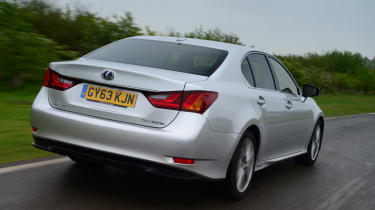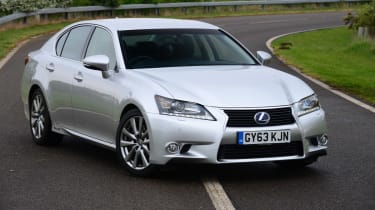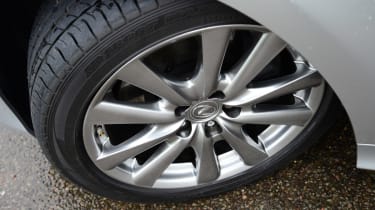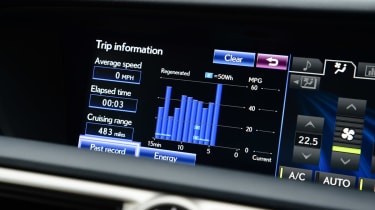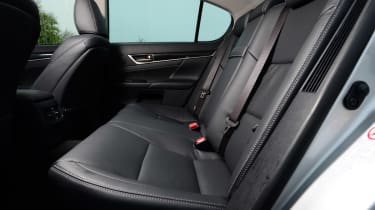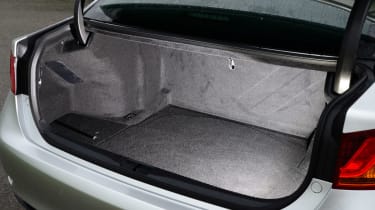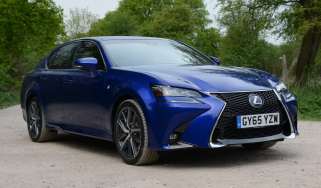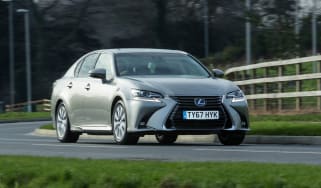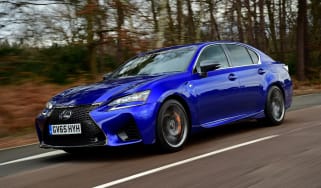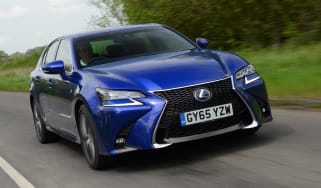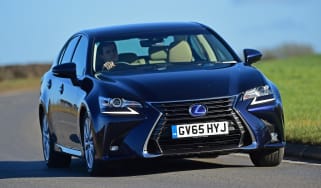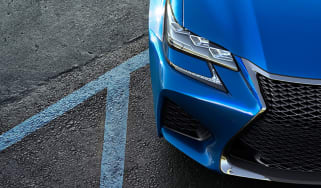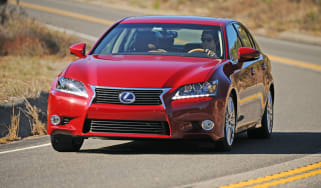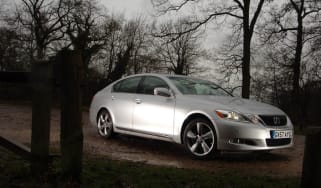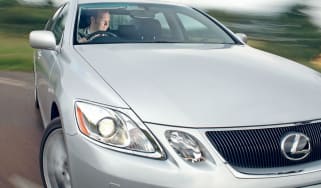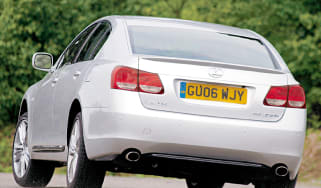Lexus GS (2012-2018) review
The Lexus GS is a serious alternative to German executive saloons, and top-spec hybrids offer great performance

The latest Lexus GS is better looking than ever, and it's also beautifully built and exceptionally refined. There are two engines in the range, the 300h and 450h.The smaller engine is a 2.5-litre four-cylinder petrol with an electric motor, while the more powerful 450h uses a 3.5-litre V6 with an electric motor.
• Lexus GS F vs Vauxhall VXR8 - video
The GS takes on company car favourites like the BMW 518d and new Audi A6 Ultra, and manages to beat them in the company car tax fight. It's well equipped too, so you're unlikely to pay much more tax on optional extras.
The GS is available in four trim levels: Executive Edition, Luxury, F Sport and Premier. We'd stick to the cheaper trim levels, especially as they come with 17-inch wheels that keep emissions low and improve comfort.
If you're in the market for an executive saloon, it's well worth considering the Lexus GS. It's comfortable, reliable, and thanks to the hybrid powertrain it's efficient too.
However, rivals like the BMW 5-Series and Audi A6 offer diesel engines for comparable running costs, and are strong performers, while also being better to drive and more spacious.
Engines, performance and drive
Accessing maximum performance doesn’t play to the Lexus’ strengths - the CVT gearbox sends the revs racing and holds them high until you back off. Even then the GS 300h takes a moment to settle back down.
Using the Lexus’ wheel-mounted paddles is a waste of time, too, because the transmission reacts too slowly and they have little effect in controlling the revs, which is infuriating. The driving experience unravels even more when you get to a corner. Firstly, the regenerative braking set-up results in an uneven and grabby pedal response, making it hard to brake progressively up to a bend. Once into the corner, the Lexus then struggles to control roll and the light steering lacks feel.
Used - available now

2021 BMW
X3
20,169 milesAutomaticPetrol2.0L
Cash £29,497
2021 Renault
Zoe
34,014 milesAutomaticElectric
Cash £10,197
2020 SEAT
Alhambra
11,780 milesAutomaticDiesel2.0L
Cash £23,999
2021 Ford
Focus Estate
18,640 milesAutomaticDiesel1.5L
Cash £18,299It’s not all bad news, though. The GS is at its best when driving gently on a part throttle, and at low speed around town the switch from silent EV to the petrol engine is seamless. However, you’ll only be able to run on the battery alone for very short periods with gentle acceleration, otherwise the internal combustion engine fires into life.
The GS is happiest when cruising on the motorway, where the cabin is free of road and wind noise. The ride is smooth, especially on 17-inch wheels, but can be a little bouncy on badly surfaced roads. Luckily the comfortable seats mean it's never really a problem.
Engines
There are two engines to choose from: an entry-level 217bhp 2.5-litre hybrid for the GS 300h and a 338bhp 3.5-litre hybrid V6 for the GS 450h.
The 300h is the one to go for if you are concerned about economy or tax, as its running costs are much lower. It does lag behind equivalent diesel rivals for power, though, and it can feel underpowered at times. The 450h is faster, but the trade-off is higher emissions and lower economy.
If you’re looking for a high performance saloon Lexus also offers the GS F. From the Japanese firm’s F Sport division, the sportiest GS model features a 5.0-litre V8 under the bonnet with 471bhp and 580Nm of torque.
MPG, CO2 and Running Costs
The GS 450h has made some huge improvements, claiming 46.3mpg, while CO2 emissions of 141g/km are impressive for such a large engine.
Taking into account tax breaks for petrol engines over diesels, the 104g/km Luxury spec GS 300h sits in a much lower tax bracket than the equivalent Audi A6 Ultra or BMW 520d, which could mean big savings over a number of years for company car customers.
The lack of turbos on the GS F performance saloon means efficiency isn’t great - Lexus claims 25.2mpg and 260g/km CO2, which means pricey road tax of £505 per year. High emissions also means it’ll be expensive for business users.
Depreciation
However, private buyers will be concerned by predicted residuals of 38.9 per cent, which could mean £4,817 more depreciation than the Audi over three years. The GS 300h will need servicing every 10,000 miles, but a fixed-price three-year deal makes it easier to budget for costs. Our quotes suggest it will still cost more than the A6 to service.
Our experts predict the GS F will hold on to 44.9 per cent of its value, so although it will lose a substantial £38,567, used values will actually be proportionally stronger than its regular stablemates.
Interior, design and technology
A recent facelift has added the current-generation Lexus family grille to the GS, and it's better looking than ever. The protruding spindle grille looks sporty, and the thinner LED headlights have improved things, too.
And while its slightly bulbous rear looks a little awkward, the big Lexus is fairly imposing. F Sport cars get a sportier look with their bigger wheels, but we'd go for the Luxury model on 17s as it will improve comfort and economy.
Lexus has gone its own way with the GS’s interior. The slickly designed dashboard is dominated by a vast, centrally mounted 12.3-inch TFT screen, while the wide centre console houses the brand’s slightly fiddly, computer mouse-influenced Remote Touch controller for the infotainment and sat-nav systems.
Happily, the smart design is accompanied by top-notch fit and finish. Quality materials are used throughout, while the beautifully damped switchgear looks and feels upmarket. Other highlights include the neatly stitched, leather-effect dash, metal-finish stereo controls and the classy analogue clock.
As you’d expect, the GS comes overflowing with standard kit, including three-zone climate control, sat-nav, heated and ventilated front seats and a 17-speaker Mark Levinson hi-fi set-up. The Lexus’ centre rear armrest folds down to reveal remote controls for the stereo, air-conditioning and heated rear bench.
The GS F ramps things up inside, with a sportier design for the cabin. this includes sports seats, some extra flashes of Alcantara and a high-tech digital rev counter that changes design depending on the driving mode. But fundamentally the F boasts the same exacting build quality as the rest of the range, with lots of expensive leather and tactile materials lining the interior.
Sat-nav, stereo and infotainment
While the sat-nav system itself comes as standard and works well, sadly the user interface is very frustrating. The mouse-like knob on the centre console makes it impossible to make an accurate selection quickly and entering a postcode is particularly fiddly.
Practicality, comfort and boot space
While the Lexus doesn't quite have the same amounts of room in the rear as its rivals, it will be fine for most uses. Adults over 6 feet tall will find it a squeeze to get behind the driver, however. The rear bench can be heated, too, while the front passenger seat has a 'chauffeur' function. This allows rear occupants to remotely slide the chair forward to create more space.
Size
The GS is 4.8m long, 1.8m wide and 1.4m high, which is similar to other cars in its class. The most notable measure is the weight - the GS is from 1,730kg-1.920kg, which is much heavier than cars like the Audi A6. That's because of the batteries for the hybrid drivetrain.
Boot
Opening the standard powered tailgate reveals a 450-litre boot. There’s significant wheelarch intrusion, while the installation of the hybrid running gear means there’s no folding rear bench or even a handy ski-hatch.
Reliability and Safety
Lexus has forged an enviable reputation for building reliable cars, and this is reflected in its impressive first-place finish in our Driver Power 2015 satisfaction survey. The GS finished 6th overall for reliability too, and since little has changed in the recent facelift we expect this one to be just as reliable. Plus, in the unlikely event something does go wrong with your car, you’ll be guaranteed first-class service from the brand’s dealers, which took overall honours in our poll every year since 2002.
The current GS hasn’t been tested by Euro NCAP, but there shouldn’t be any concerns about safety. All models get 10 airbags, stability control, blind spot monitoring and rear cross traffic alert, which warns the driver of approaching cars when reversing out of a space.

